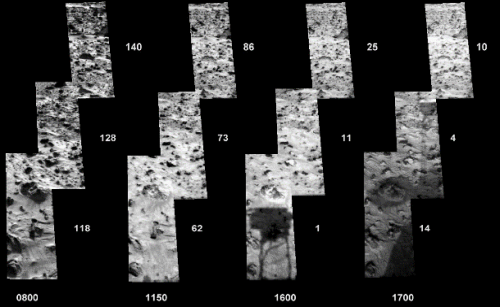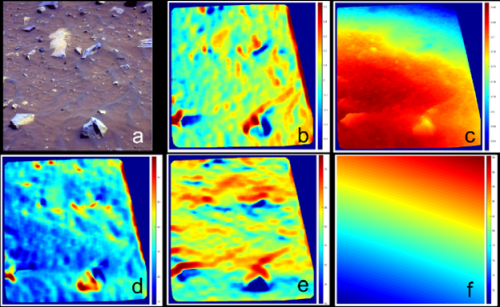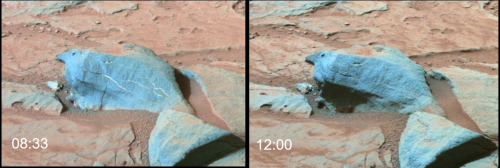In Situ Spectrophotometric Observations of Mars from Viking to Perseverance
- 1United States of America (jeffrey.r.johnson@jhuapl.edu)
- 2Arizona State University
- 3Space Science Institute
- 4Lowell Observatory
- 5Cornell University
- 6University of Arizona
- 7Jet Propulsion Laboratory
- 8USGS
- 9University of Copenhagen
- 10University of Washington, St. Louis
The reflection of visible/near-infrared light from Mars can vary depending on the directional scattering characteristics of surface materials. Multispectral images have been acquired in situ under different illumination/viewing angles by the Viking and Mars Pathfinder landers, the Mars Exploration Rovers (MER), the Mars Science Laboratory (MSL) Curiosity, and the Mars 2020 (M2020) Perseverance rover. We review the use of these data sets with radiative transfer models to constrain the single scattering albedo (w), phase function, surface roughness, grain size and/or porosity of martian materials.
Soils at the Viking Lander sites were modeled with the initial version of the Hapke model [1], which showed wavelength–dependent backscattering phase functions [1-3] (Fig. 1). Model results suggested that variations in thickness of nanophase ferric oxide coatings could explain differences between darker and brighter rock facet colors [4]. Surfaces exhibited a strong opposition effect and smooth rock surfaces exhibited specular reflections, consistent with rocks abraded by wind [4].
Fig. 1. Viking Lander 2 red filter images: (a) Sol 045, incidence=85.1° showing pronounced specular reflection in ~20 cm rock (arrow); (b) Sol 025, incidence=29.1°[4].
The Imager for Mars Pathfinder (IMP) acquired multispectral images at phase angles from near 0° to ~155°. “Bright soil” materials appeared brighter and redder than “dark soil” materials, whereas “gray” rocks were interpreted to be relatively less dust-covered than “red” rocks [5]. The phase curves suggested a dominantly backscattering function, although a strong forward scattering component was observed for gray rocks. The w values of bright soils were highest in red and near-infrared bands, whereas w for gray rocks was highest at 443 nm. The single particle scattering function parameters b (asymmetry parameter) and c (backscattering fraction) were compared to those modeled from laboratory data of artificial particle types [6]. Soils and red rocks clustered at high c values, near materials with a high density of internal scatterers. The gray rocks exhibited lower c values similar to agglutinates and rough, clear spheres, consistent with smooth surfaces (possibly a coating) similar to terrestrial varnished rock surfaces [4,6]. The opposition width parameter h was relatively larger for the dark soils, implying materials with lower porosity and/or a more uniform particle size distribution. Conversely, the gray rocks’ low values suggested materials with higher porosity and/or a broader particle size distribution than red rocks. The opposition effect amplitude (B0) decreased with increasing wavelength, which suggested that these materials were more opaque (more surface scattering) in blue wavelengths, and become more transparent (more internal scattering) at longer wavelengths [cf. 8].

Fig. 2. IMP images (752 nm) with acquisition times (bottom) and phase angles (sides) shown. Note shadow of IMP camera head in 16:00 and 17:00 images[5].
Spectrophotometric observations acquired throughout the MER missions by the Panoramic Cameras (Pancams) were used to investigate the surface scattering properties of the basaltic rocks and soils in Gusev crater (Spirit) and the sulfate-rich outcrop rocks, hematite-bearing spherules and basaltic sands in Meridiani Planum (Opportunity) (Fig. 3). A Hapke model [9] was used in combination with corrections for diffuse sky illumination and local surface facet orientations (derived from stereo images) to analyze photometric observations [10-13] (Fig 4.). At the Spirit site, modeled w values among all typical “Soil” units were similar except for areas subjected wind events. “Gray” rocks were less contaminated with dusty coatings than “Red” rocks and were typically more forward scattering. Gray rock surfaces were consistent with rough/irregular particles with few internal scatterers [6], whereas Red rock and most Soil surfaces exhibited more internal heterogeneity. Most Red rocks and Soils were more porous (or exhibited a less uniform grain size) than Gray rocks and generally exhibited lower macroscopic roughness values. The w values of spherule-rich soils along the Opportunity traverse varied (due to dust coatings), and outcrop rocks exhibited the highest w values. Spherule soils were typically backscattering and consistent with particles with internal scatterers and/or rough, clear spheres. Observations of large drifts were modeled with w values that exhibited a downturn toward 1009 nm, consistent with minor hydration [14]. These “Dust” deposits were the smoothest of all units studied by Opportunity and exhibited the highest h values, suggesting a more homogeneous grain size distribution and/or lower porosity.
Fig. 3. MER Opportunity Pancam images of Tipuna rock on Sols 306-307 (a)09:06, (b)11:42, (c)14:46, (d) 16:08, (e) 17:05[11].

Fig 4. Example of geometric information computed from MER Spirit Pancam stereo images from the Troy area: (a) false-color image, Sol 1944, 10:32; (b) surface normal (x direction); (c) z-value; (d) incidence; (e) emission; (f) phase angle[15].
MSL has collected twenty spectrophotometric Mastcam datasets (including Navigation Camera stereo images for topography) (Fig. 5), along with five data sets using the MAHLI camera on the arm as a goniometer to acquire phase angle coverage [16]. Analyses have revealed a combination of typical effects associated with dust coatings but also changes in absorption band strengths with phase angle and phase reddening effects [e.g., 17-19]. Recently, photometric data were collected by the Perseverance Mastcam-Z camera east of the landing site (Fig. 6), imaging sand ripples, rover tracks, and rocks with variable degrees of dust and coatings, whose spectra varied with phase angle.

Fig 5. MSL Mastcam false-color images (Sol 172) acquired at times shown; note enhanced visibility of light-toned veins at low phase angle [cf.18-19].
Fig 6. Perseverance Mastcam-Z false-color mosaics looking east near M2020 landing site (times 10:30(left), 17:10(right)).
A common theme among these in situ studies is the dominantly backscattering nature of the martian surface, modulated by the presence of dust coatings. This photometric variability encourages ongoing refinement of radiative transfer methods to help categorize and map distinct photometric units on Mars, particularly in support of ongoing and upcoming orbital and landed missions.
[1]Hapke,B.,JGR,86,3039-3054,1981
[2]Guinness,E.A.,JGR,86,7983-7992,1981
[3]Guinness,E.A.,etal.,JGR,92,E575-E587,1987
[4]Guinness,E.A.,etal.,JGR,102,28687-28703,1997
[5]Johnson,J.R.,etal.,JGR,104,8809-8830,1999
[6]McGuire,A.F.,and B.Hapke,Icarus,113,134-155,1995
[7]McSween,H.Y.Jr.,etal.,JGR.,111,E02S10,doi:10.1029/2005JE002477,2006
[8]Domingue,D.,and B.Hapke,Icarus,99,70-81,1992
[9]Hapke,B.,Theory of Reflectance/Emittance Spectroscopy,Cambridge-University-Press,455p.,1993
[10]Johnson,J.R.,etal.,JGR,111,E02S14,doi:10.1029/2005JE002494,2006
[11]Johnson,J.R.,etal.,JGR.,111,E12S16,doi:10.1029/2006JE002762,2006
[12]Johnson,J.R.,etal.,Ch. 19,in The Martian Surface: Composition,Mineralogy,and Physical Properties,Cambridge University Press,428-450,2008
[13]Johnson,J.R,etal.,Icarus,248,25-71,doi:10.1016/j.icarus.2014.10.026,2015
[14]Rice,M.S.,etal., Icarus 205,375-395,2010
[15]Johnson,J.R.,etal.,Icarus,357,114261,doi.org/10.1016/j.icarus.2020.114261,2021
[16]Liang,W.,etal.,Icarus,335,13361,,doi.org/10.1016/j.icarus.2019.06.022,2020
[17]Johnson,J.R.,etal.,LPSC,#1371,2014
[18]Johnson,J.R.etal.,LPSC,#1354,2018
[19]Johnson,J.R.,etal.,LPSC,#1313,2019
How to cite: Johnson, J., Bell III, J., Lemmon, M., Grundy, W., Hayes, A., Liang, W., Deen, R., Herkenhoff, K., Kinch, K., and Arvidson, R.: In Situ Spectrophotometric Observations of Mars from Viking to Perseverance, European Planetary Science Congress 2021, online, 13–24 Sep 2021, EPSC2021-61, https://doi.org/10.5194/epsc2021-61, 2021.

